Abstract
This article analyzes 10 studies that assessed the association of socioeconomic status (SES) with cancer occurrence among blacks and whites in the United States. The following summative inferences were made: the associations of SES with cancer are similar among blacks and whites; cancers of organ sites with the most intimate environmental interfaces have the strongest SES-cancer associations (stomach, lung, cervix, and rectum); the prevalence of exposure to low socioeconomic-related risks such as poverty are approximately fourfold greater among blacks; the all-site population attributable risk percent due to low socioeconomic exposure among blacks is estimated to be four times that of whites, and similar data trends were observed for individual cancer sites such as the stomach and lung; and the three cancer sites of the stomach, lung, and cervix uteri account for nearly half of the observed US black-white cancer rate difference. This review also found all 10 of the primary studies in this field to be ecological with respect to socioeconomic exposure measurement, ie, they used aggregate measures (eg, census tract median education or family income) to characterize the individual's exposure. The need for direct empirical validation of such measures to aid in interpretation of the extant data in this field is underscored.
Full text
PDF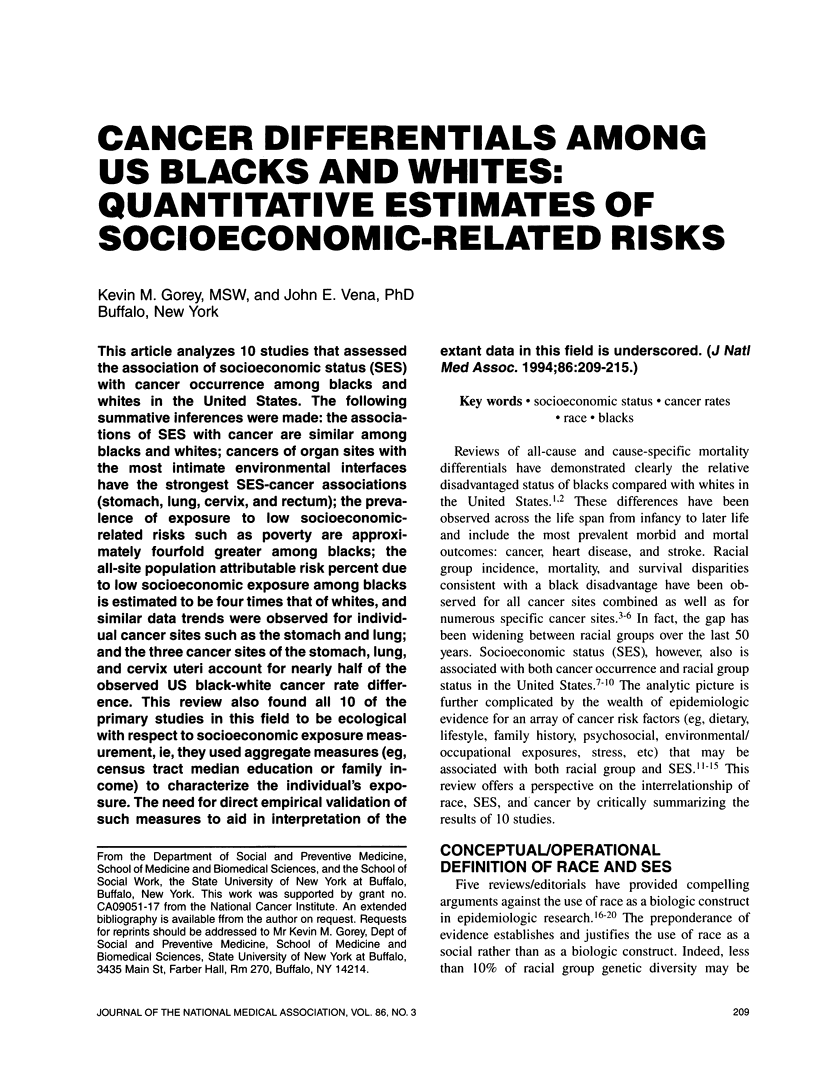
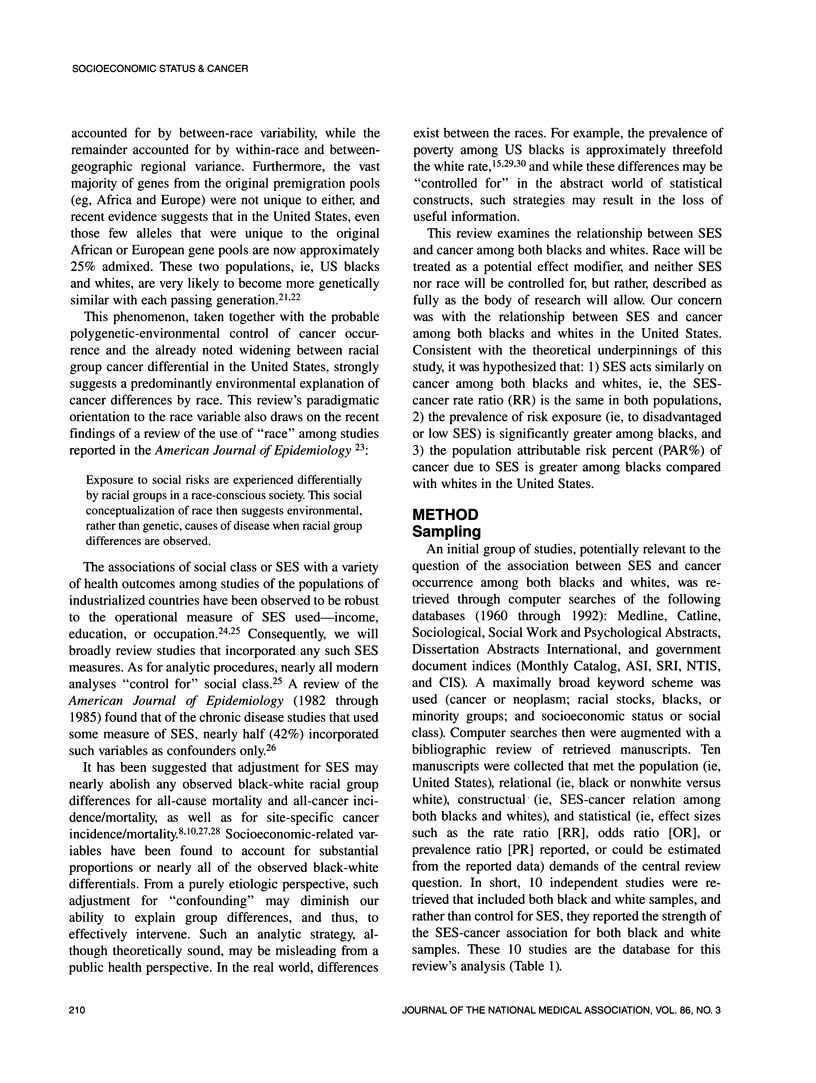
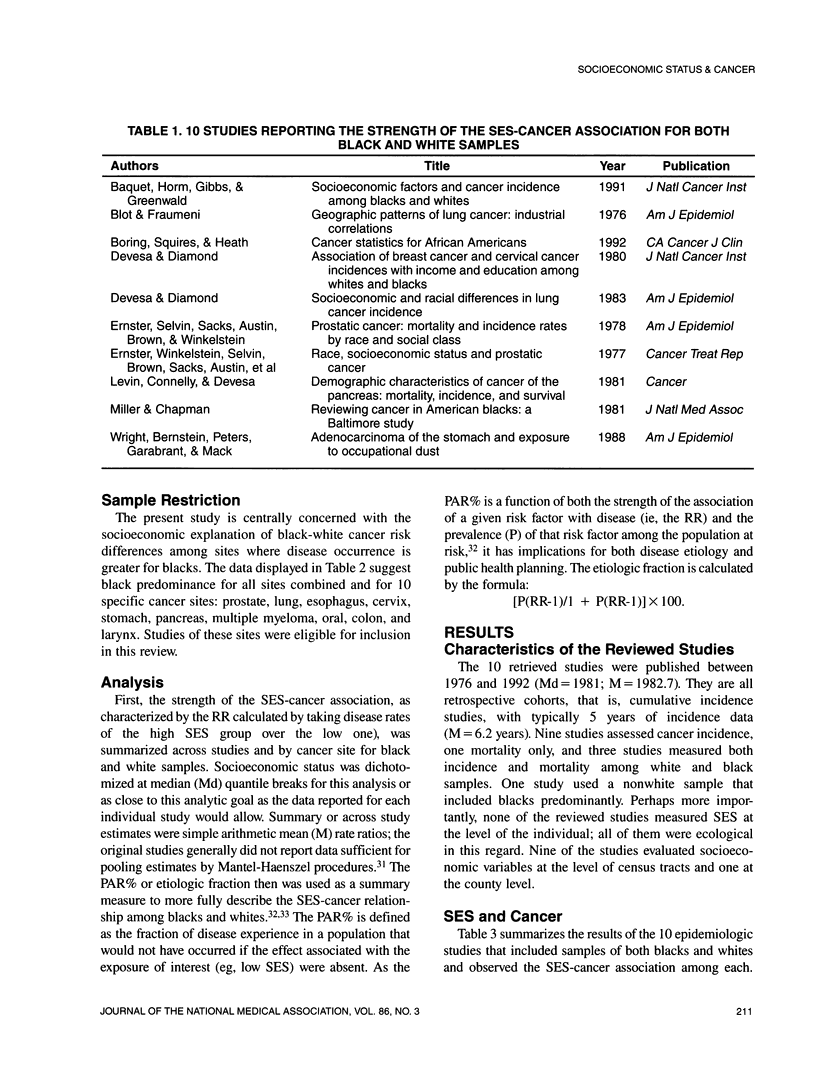
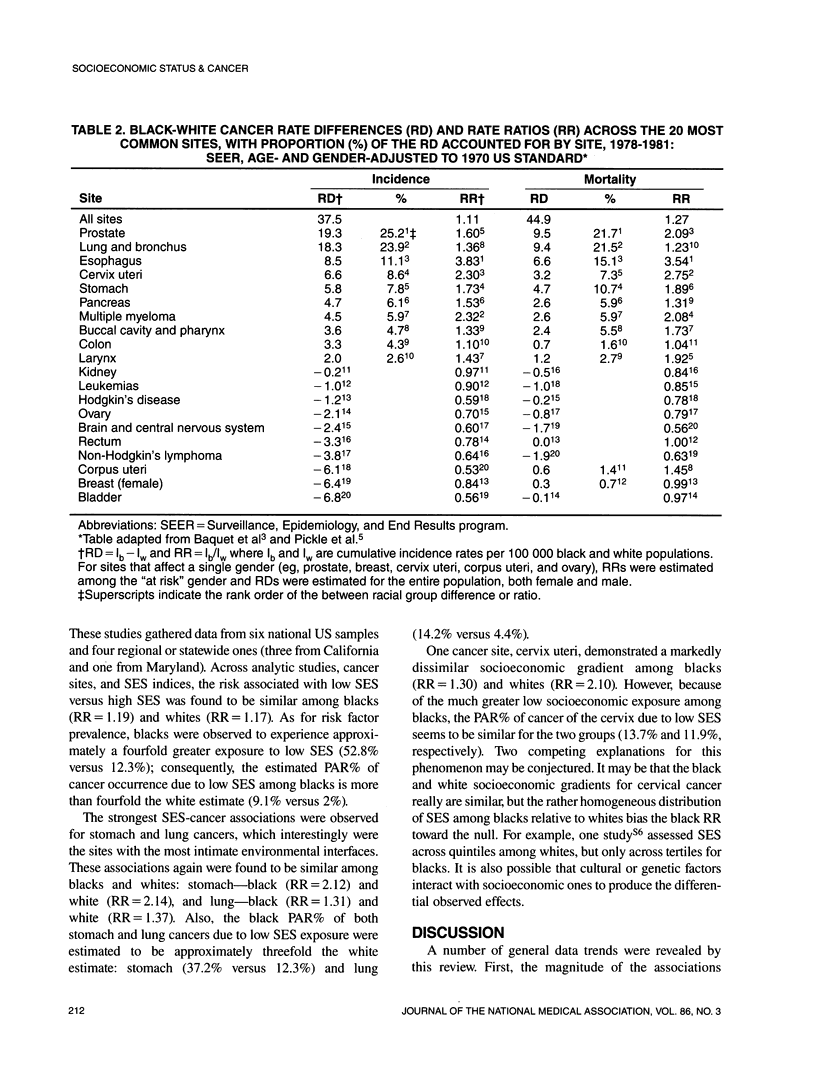
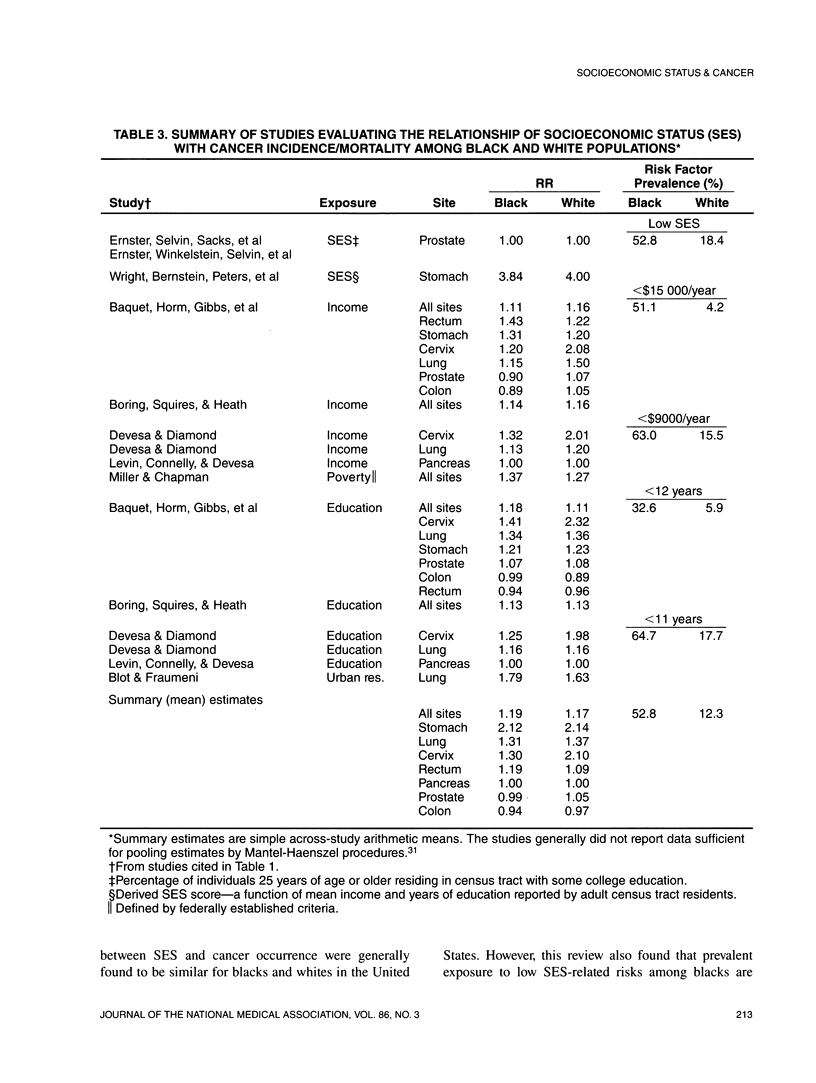
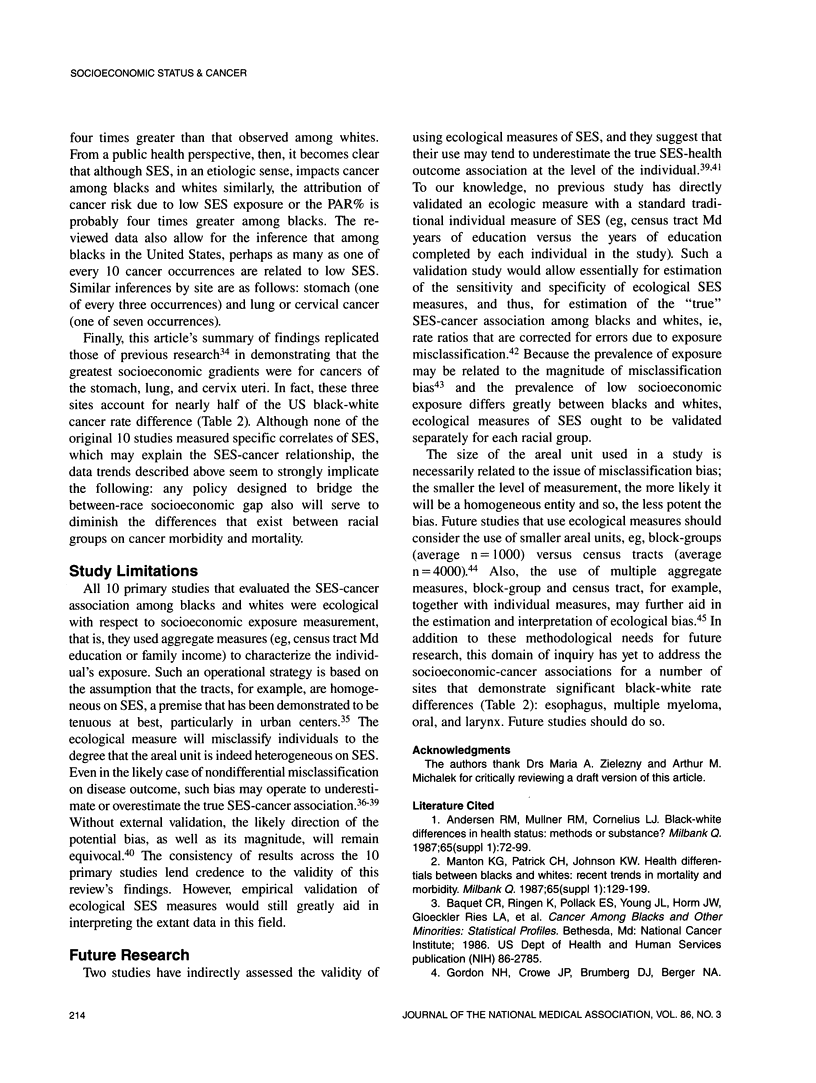
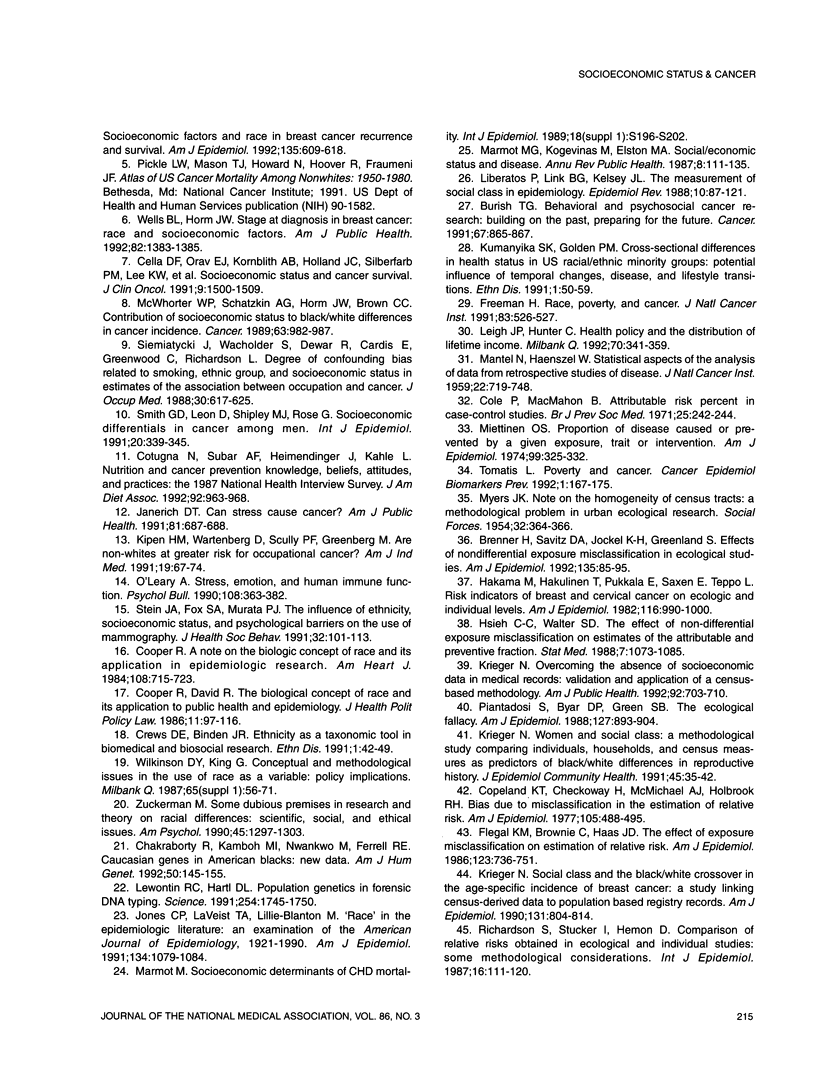
Selected References
These references are in PubMed. This may not be the complete list of references from this article.
- Andersen R. M., Mullner R. M., Cornelius L. J. Black-white differences in health status: methods or substance? Milbank Q. 1987;65 (Suppl 1):72–99. [PubMed] [Google Scholar]
- Brenner H., Savitz D. A., Jöckel K. H., Greenland S. Effects of nondifferential exposure misclassification in ecologic studies. Am J Epidemiol. 1992 Jan 1;135(1):85–95. doi: 10.1093/oxfordjournals.aje.a116205. [DOI] [PubMed] [Google Scholar]
- Burish T. G. Behavioral and psychosocial cancer research. Building on the past, preparing for the future. Cancer. 1991 Feb 1;67(3 Suppl):865–867. doi: 10.1002/1097-0142(19910201)67:3+<865::aid-cncr2820671420>3.0.co;2-n. [DOI] [PubMed] [Google Scholar]
- Cella D. F., Orav E. J., Kornblith A. B., Holland J. C., Silberfarb P. M., Lee K. W., Comis R. L., Perry M., Cooper R., Maurer L. H. Socioeconomic status and cancer survival. J Clin Oncol. 1991 Aug;9(8):1500–1509. doi: 10.1200/JCO.1991.9.8.1500. [DOI] [PubMed] [Google Scholar]
- Chakraborty R., Kamboh M. I., Nwankwo M., Ferrell R. E. Caucasian genes in American blacks: new data. Am J Hum Genet. 1992 Jan;50(1):145–155. [PMC free article] [PubMed] [Google Scholar]
- Cole P., MacMahon B. Attributable risk percent in case-control studies. Br J Prev Soc Med. 1971 Nov;25(4):242–244. doi: 10.1136/jech.25.4.242. [DOI] [PMC free article] [PubMed] [Google Scholar]
- Cooper R. A note on the biologic concept of race and its application in epidemiologic research. Am Heart J. 1984 Sep;108(3 Pt 2):715–722. doi: 10.1016/0002-8703(84)90662-8. [DOI] [PubMed] [Google Scholar]
- Cooper R., David R. The biological concept of race and its application to public health and epidemiology. J Health Polit Policy Law. 1986 Spring;11(1):97–116. doi: 10.1215/03616878-11-1-97. [DOI] [PubMed] [Google Scholar]
- Copeland K. T., Checkoway H., McMichael A. J., Holbrook R. H. Bias due to misclassification in the estimation of relative risk. Am J Epidemiol. 1977 May;105(5):488–495. doi: 10.1093/oxfordjournals.aje.a112408. [DOI] [PubMed] [Google Scholar]
- Cotugna N., Subar A. F., Heimendinger J., Kahle L. Nutrition and cancer prevention knowledge, beliefs, attitudes, and practices: the 1987 National Health Interview Survey. J Am Diet Assoc. 1992 Aug;92(8):963–968. [PubMed] [Google Scholar]
- Crews D. E., Bindon J. R. Ethnicity as a taxonomic tool in biomedical and biosocial research. Ethn Dis. 1991 Winter;1(1):42–49. [PubMed] [Google Scholar]
- Freeman H. Race, poverty, and cancer. J Natl Cancer Inst. 1991 Apr 17;83(8):526–527. doi: 10.1093/jnci/83.8.526. [DOI] [PubMed] [Google Scholar]
- Hakama M., Hakulinen T., Pukkala E., Saxén E., Teppo L. Risk indicators of breast and cervical cancer on ecologic and individual levels. Am J Epidemiol. 1982 Dec;116(6):990–1000. doi: 10.1093/oxfordjournals.aje.a113501. [DOI] [PubMed] [Google Scholar]
- Hsieh C. C., Walter S. D. The effect of non-differential exposure misclassification on estimates of the attributable and prevented fraction. Stat Med. 1988 Oct;7(10):1073–1085. doi: 10.1002/sim.4780071008. [DOI] [PubMed] [Google Scholar]
- Janerich D. T. Can stress cause cancer? Am J Public Health. 1991 Jun;81(6):687–688. doi: 10.2105/ajph.81.6.687. [DOI] [PMC free article] [PubMed] [Google Scholar]
- Jones C. P., LaVeist T. A., Lillie-Blanton M. "Race" in the epidemiologic literature: an examination of the American Journal of Epidemiology, 1921-1990. Am J Epidemiol. 1991 Nov 15;134(10):1079–1084. doi: 10.1093/oxfordjournals.aje.a116011. [DOI] [PubMed] [Google Scholar]
- Kipen H. M., Wartenberg D., Scully P. F., Greenberg M. Are non-whites at greater risk for occupational cancer? Am J Ind Med. 1991;19(1):67–74. doi: 10.1002/ajim.4700190109. [DOI] [PubMed] [Google Scholar]
- Krieger N. Overcoming the absence of socioeconomic data in medical records: validation and application of a census-based methodology. Am J Public Health. 1992 May;82(5):703–710. doi: 10.2105/ajph.82.5.703. [DOI] [PMC free article] [PubMed] [Google Scholar]
- Krieger N. Women and social class: a methodological study comparing individual, household, and census measures as predictors of black/white differences in reproductive history. J Epidemiol Community Health. 1991 Mar;45(1):35–42. doi: 10.1136/jech.45.1.35. [DOI] [PMC free article] [PubMed] [Google Scholar]
- Kumanyika S. K., Golden P. M. Cross-sectional differences in health status in US racial/ethnic minority groups: potential influence of temporal changes, disease, and life-style transitions. Ethn Dis. 1991 Winter;1(1):50–59. [PubMed] [Google Scholar]
- Leigh J. P., Hunter C. Health policy and the distribution of lifetime income. Milbank Q. 1992;70(2):341–359. [PubMed] [Google Scholar]
- Lewontin R. C., Hartl D. L. Population genetics in forensic DNA typing. Science. 1991 Dec 20;254(5039):1745–1750. doi: 10.1126/science.1845040. [DOI] [PubMed] [Google Scholar]
- Liberatos P., Link B. G., Kelsey J. L. The measurement of social class in epidemiology. Epidemiol Rev. 1988;10:87–121. doi: 10.1093/oxfordjournals.epirev.a036030. [DOI] [PubMed] [Google Scholar]
- Manton K. G., Patrick C. H., Johnson K. W. Health differentials between blacks and whites: recent trends in mortality and morbidity. Milbank Q. 1987;65 (Suppl 1):129–199. [PubMed] [Google Scholar]
- Marmot M. Socioeconomic determinants of CHD mortality. Int J Epidemiol. 1989;18(3 Suppl 1):S196–S202. [PubMed] [Google Scholar]
- McWhorter W. P., Schatzkin A. G., Horm J. W., Brown C. C. Contribution of socioeconomic status to black/white differences in cancer incidence. Cancer. 1989 Mar 1;63(5):982–987. doi: 10.1002/1097-0142(19890301)63:5<982::aid-cncr2820630533>3.0.co;2-i. [DOI] [PubMed] [Google Scholar]
- Miettinen O. S. Proportion of disease caused or prevented by a given exposure, trait or intervention. Am J Epidemiol. 1974 May;99(5):325–332. doi: 10.1093/oxfordjournals.aje.a121617. [DOI] [PubMed] [Google Scholar]
- O'Leary A. Stress, emotion, and human immune function. Psychol Bull. 1990 Nov;108(3):363–382. doi: 10.1037/0033-2909.108.3.363. [DOI] [PubMed] [Google Scholar]
- Piantadosi S., Byar D. P., Green S. B. The ecological fallacy. Am J Epidemiol. 1988 May;127(5):893–904. doi: 10.1093/oxfordjournals.aje.a114892. [DOI] [PubMed] [Google Scholar]
- Richardson S., Stücker I., Hémon D. Comparison of relative risks obtained in ecological and individual studies: some methodological considerations. Int J Epidemiol. 1987 Mar;16(1):111–120. doi: 10.1093/ije/16.1.111. [DOI] [PubMed] [Google Scholar]
- Siemiatycki J., Wacholder S., Dewar R., Cardis E., Greenwood C., Richardson L. Degree of confounding bias related to smoking, ethnic group, and socioeconomic status in estimates of the associations between occupation and cancer. J Occup Med. 1988 Aug;30(8):617–625. doi: 10.1097/00043764-198808000-00004. [DOI] [PubMed] [Google Scholar]
- Smith G. D., Leon D., Shipley M. J., Rose G. Socioeconomic differentials in cancer among men. Int J Epidemiol. 1991 Jun;20(2):339–345. doi: 10.1093/ije/20.2.339. [DOI] [PubMed] [Google Scholar]
- Stein J. A., Fox S. A., Murata P. J. The influence of ethnicity, socioeconomic status, and psychological barriers on use of mammography. J Health Soc Behav. 1991 Jun;32(2):101–113. [PubMed] [Google Scholar]
- Tomatis L. Poverty and cancer. Cancer Epidemiol Biomarkers Prev. 1992 Mar-Apr;1(3):167–175. [PubMed] [Google Scholar]
- Wells B. L., Horm J. W. Stage at diagnosis in breast cancer: race and socioeconomic factors. Am J Public Health. 1992 Oct;82(10):1383–1385. doi: 10.2105/ajph.82.10.1383. [DOI] [PMC free article] [PubMed] [Google Scholar]
- Wilkinson D. Y., King G. Conceptual and methodological issues in the use of race as a variable: policy implications. Milbank Q. 1987;65 (Suppl 1):56–71. [PubMed] [Google Scholar]
- Zuckerman M. Some dubious premises in research and theory on racial differences. Scientific, social, and ethical issues. Am Psychol. 1990 Dec;45(12):1297–1303. doi: 10.1037//0003-066x.45.12.1297. [DOI] [PubMed] [Google Scholar]


